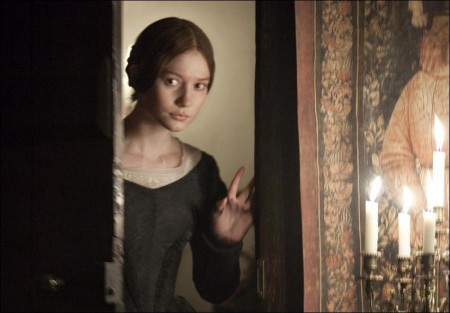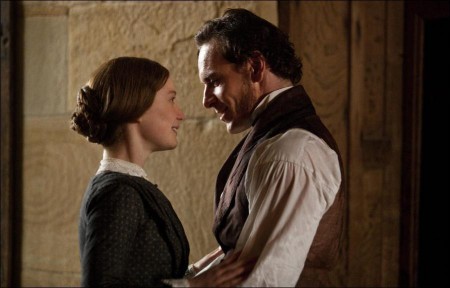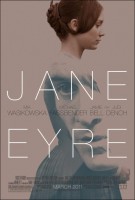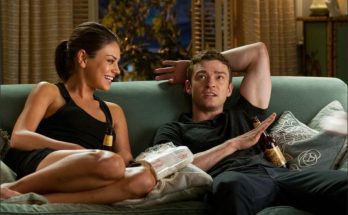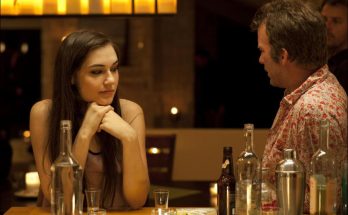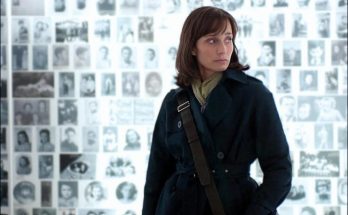Mia Wasikowska (“Alice in Wonderland”) and Michael Fassbender (“Inglourious Basterds”) star in the romantic drama based on Charlotte Brontë’s classic novel, from acclaimed director Cary Fukunaga (“Sin Nombre”). In the story, Jane Eyre flees Thornfield House, where she works as a governess for wealthy Edward Rochester.
As she reflects upon the people and emotions that have defined her, it is clear that the isolated and imposing residence – and Mr. Rochester’s coldness – have sorely tested the young woman’s resilience, forged years earlier when she was orphaned. She must now act decisively to secure her own future and come to terms with the past that haunts her – and the terrible secret that Mr. Rochester is hiding and that she has uncovered…
Based on Charlotte Brontë’s classic novel, the romantic drama stars Mia Wasikowska (“Alice in Wonderland”) and Michael Fassbender (“Inglourious Basterds”) in the lead roles. In the story, Jane Eyre flees Thornfield House, where she works as a governess for wealthy Edward Rochester. The isolated and imposing residence – and Mr. Rochester’s coldness – have sorely tested the young woman’s resilience, forged years earlier when she was orphaned. As Jane reflects upon her past and recovers her natural curiosity, she will return to Mr. Rochester – and the terrible secret that he is hiding…
Return to Thornfield
For over 160 years, Charlotte Brontë’s novel Jane Eyre has been one of the world’s most popular books. A mainstay of school reading lists, it has been translated into virtually every language. A story with a protagonist whom Brontë saw as “a heroine as plain and small as myself,” it continues to inspire generations and to influence storytellers.
The power of the story and the popularity of the 1847 novel have led to a host of adaptations of the book; there have been 18 feature versions (dating back to 1910, and most recently in 1996), and 9 telefilm versions. The team behind what would become the 2011 version, Jane Eyre, was motivated to reach a world filmgoing audience while also honoring the novel.
Producer Alison Owen, an Academy Award nominee and Emmy Award winner, offers, “If you say to someone, ‘What’s the definitive film version of Jane Eyre?’ no one really has an answer. Having made a number of movies from or about women’s fiction, I wondered, ‘Why not?’”
“We’re a company that is rapidly building a healthy reputation for being able to successfully convert well-known written works into big- and small-screen entertainment. Taking on Brontë seemed like the natural next step up the literary ladder,” adds producer Paul Trijbits. “It’s a book we already knew had an enormous fan base, so the responsibility was also a major consideration. We wanted to move this interpretation forward into the 21st Century whilst maintaining the story’s haunting beauty.”
Owen and Trijbits’ Ruby Film & Television began work on the project, which they took to one of the U.K.’s most prolific film funding organizations, BBC Films, to begin the development process.
Owen adds, “It’s timely in that Charlotte Brontë, seen as ‘the darker sister’ when compared to Emily and Anne Brontë, is being rediscovered much like Jane Austen was nearly 20 years ago.
“As a producer, I make sure to have general meetings with my favorite writers all the time; right after I’d thought about Jane Eyre, I was meeting with Moira Buffini. I happened to mention it and it turned out to be one of Moira’s favorite books, if not her favorite.”
Buffini seized on the chance to adapt the book, and she and Owen quickly outlined their vision for a full-on big-screen approach to the story. They knew it had to differ from adaptations that had gone before. Buffini’s approach was to draw out the gothic elements of the story, and make them engines of the piece. “Moira wanted to make it dark and spooky on an intensely romantic journey. That was her take, which I wholly supported,” recalls Owen.
Further, as the novel would be adapted into a two-hour movie, Owen found that “what was brilliant about the script Moira delivered was the structure she’d chosen. The book is quite difficult in some ways to translate to film. Everyone remembers the sections of Jane’s childhood, of Jane being a governess at Thornfield and falling in love with Mr. Rochester, and then bolting.
“But from then on, there’s another set of characters introduced – the Rivers family. You can do that in a novel, but it’s harder to do two-thirds of the way through a movie. Moira’s stroke of genius was that instead of abbreviating or losing this part entirely, which previous adaptations have done, she put it right at the beginning – and turned the novel’s early sections of the young Jane at Lowood and her initial days at Thornfield into flashbacks. Therefore, midway through the third act, we catch up with Jane and you get the emotional punch of being in real time at the end as she comes to terms with everyone and everything.”
Buffini comments, “I hope this will please the many who love the book; while we may not be faithful to the original structure, our version does include every key stage of Jane’s story. Giving the complete picture was also meant to help the uninitiated – those coming to this story for the first time – to understand and identify with Jane all the more.”
Once the script was ready, Owen sought a director who would be on the same wavelength. Student Academy Award winner Cary Joji Fukunaga had just made his breakthrough feature debut, Focus Features’ Sin Nombre, which earned critical acclaim and awards beginning with its world premiere at the 2009 Sundance Film Festival and continuing on through its global release.
The epic dramatic thriller about Central American immigrants seeking the promise of the U.S., “although seemingly quite far removed from the story of Jane Eyre, also tackled the subject of loss and the search for a better life,” notes the producer. “What is apparent as soon as you watch Cary’s work is that he’s a visceral filmmaker with a strong auteur voice – something that we very much wanted for Jane Eyre.”
Fukunaga admits to having entertained the idea of a Jane Eyre movie before, noting that “a few years ago, after writing Sin Nombre but prior to shooting it, I was looking for material to adapt that was in the public domain. Jane Eyre was one of the first novels to pop into my head. I’ve always liked exploring the idea of ‘family’ or lack thereof, and particularly remembered the protagonist’s having to overcome so many challenges in her youth to find love and true family.
“While I was in the U.K. for the opening of Sin Nombre, I learned that a feature version of Jane Eyre was in development. I wanted a chance to read what was being done, so I arranged a meeting.”
However, having previously been writer / director, Fukunaga admits that the prospect of collaborating with a screenwriter made him “apprehensive at first. What made it viable to me was that Moira’s adaptation was founded on a structure that had an immediate, contemporary feel, while also remaining faithful to the story. I could see the movie I wanted to make out of it, so it was a compelling and convincing starting point. At the end of my very first meeting with Alison and Moira I said, ‘I’d like to make this movie’ and, surprisingly, they said, ‘We’d like you to make this movie.’ So it was off to the races.”
Owen remembers, “Cary read the script and immediately responded with such passion. He really got it! When you meet someone, and they are on the same page as you, it’s as strong an indication as any that they’re the right person to make the movie. He explained from the outset how he would like to cast it younger than might be expected and how he had ideas to bring out the gothic elements. That was all music to Moira’s and my ears.”
Fukunaga notes, “I knew I was taking on a story that is a period film and a romance with elements of horror. Walking the line among these tones would be difficult, because it’s easier to default to one or the other. I wanted to maintain consistency in the style of telling the story.”
He offers, “Where Jane Eyre is similar to Sin Nombre is in its exploration of the mysteries of human relationships, especially familial ones. Jane hasn’t had a family her whole life and is in search of one, not to mention a place to call home. But every time she becomes close to someone, they are taken away from her. “Another similar theme is that a female protagonist is on a journey and finds someone she can relate to, who has suffered loss like she has, as she is plunged into complex situations and emotions. With secrets from the past emerging, will she once again lose someone close to her?”
Fukunaga called in a key collaborator from Sin Nombre early on, director of photography Adriano Goldman, who reports that “for a cinematographer from Brazil, the prospect of shooting a period film in England was so intriguing, that it was enough for me to commit.”
They decided, says Fukunaga, that their approach to Jane Eyre “was to be more traditional [than Sin Nombre’s shooting style]. For one thing, on this movie we had trained actors. We never considered going digital; this was always going to be filmed in 35mm.
“The next question was, which shooting format? 2:35/1 is the obvious choice for an historical film. But what are important in Jane Eyre are the relationships; Rochester and Jane’s pivots on tête-à-tête conversations, and there is tension underneath. So we flirted with going 1:33/1, which would certainly have put the focus on the characters. But we felt that the way to go was 1:85/1, which is old school yet still gives you a lot of screen space.”
Jane Eyre
Directed by: Cary Fukunaga
Starring: Mia Wasikowska, Jamie Bell, Su Elliot, Holly Grainger, Sally Hawkins, Tamzin Merchant, Amelia Clarkson, Sally Hawkins, Jayne Wiseler, Freya Wilson, Emily Haigh
Screenplay by: Charlotte Brontë, Moira Buffini
Production Design by: Will Hughes-Jones
Cinematography by: Adriano Goldman
Film Editing by: Melanie Oliver
Costume Design by: Michael O’Connor
Set Decoration by: Tina Jones
Art Direction by: Karl Probert
Music by: Dario Marianelli
MPAA Rating: PG-13 for some thematic elements including a nude image and brief violent content.
Studio: Focus Features
Release Date: March 11, 2011
Hits: 110
